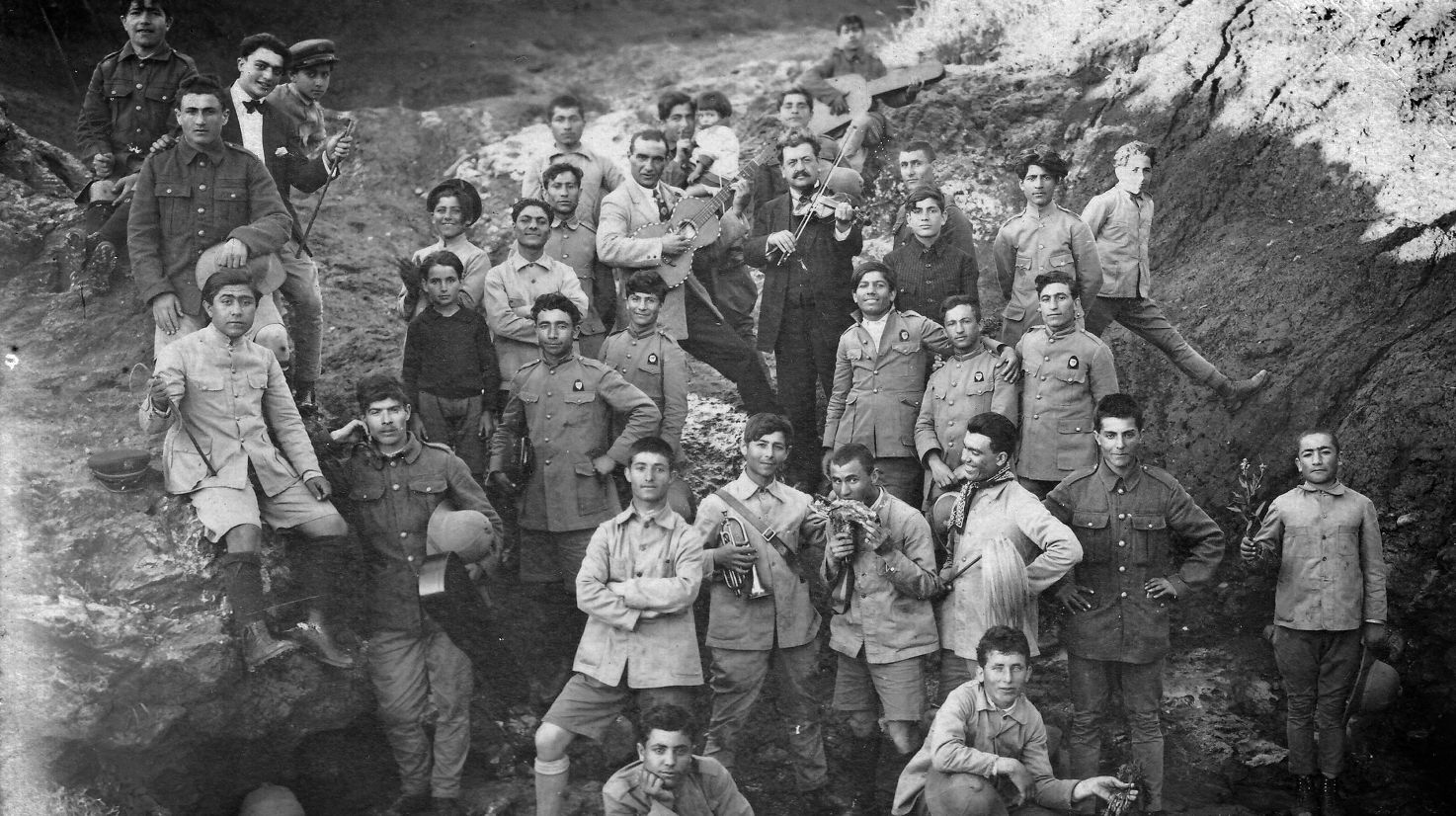Ethiopian Emperor Haile Selassie’s Musical Band of Armenian Orphans

A bond forged through a common Orthodox faith left a lasting imprint on Ethiopia’s music
Before continuing toward Europe, Tafari made a stop in Jerusalem. Back home, the Ethiopian Church questioned the prince’s religious devotion, so the visit was meant to be a symbolic demonstration of his piety. Tafari made his way to the Armenian quarter because of the Armenian church’s long-standing relationship with the Ethiopian branch of Christianity.
There, he was welcomed by a brass band of 40 young schoolchildren from the quarter’s orphanage. All of them had lost their parents in the 1915 Armenian genocide. Tafari was captivated by the children and asked for permission to bring them back with him to Addis Ababa. The orphans, Tafari planned, would form his country’s first imperial band.
That fall, when the children arrived in Addis Ababa, the prince received them at his royal palace. “You are my children; do not ever worry about anything; I shall watch over you as if you were my own children,” he told them, according to a letter written by the band’s conductor, Kevork Nalbandian.
The orphans joined an already thriving community of Armenians, one that had contributed profoundly to the development of Ethiopian civil life for over a century. Though most of the children did not remain in Addis Ababa for long, the Armenian influence on Ethiopian modern music and cultural life continues to be felt long after the community’s departure. Now, fewer than 100 Armenians remain in the country, yet Armenians the world over remember this close link with Ethiopia, symbolized by the adoption of 40 musical children. And their legacy has extended far beyond their lifetimes: Ethiopian music, exported around the world, still retains the mark of this band of orphans.
Armenian merchants and clergy began traveling to Ethiopia as early as the 16th century, but it was not until the 1860s that a small community began to form. These Armenians who settled in Addis Ababa in the 19th century practiced a variety of specialized artisanal, manufacturing and professional trades, working as cobblers, tailors, builders, jewelers, mechanics, lawyers, architects and physicians.
At the time, Ethiopia was actively seeking the skills of foreign workers to help develop its economy, but it needed to be selective. As a lone African holdout against colonialism, the country’s aristocracy wanted to be sure that their associates would not betray them. The Armenians emerged as the natural choice. Besides the fact that the two both cleaved to the same Oriental Orthodox branch of Christianity, the Ethiopians were comforted by the fact that the Armenians were stateless. Unlike other foreign ethnic groups living in Ethiopia at the time, like the Italians and Greeks, the Armenians were not thought of as a colonial threat.
Many Armenians were thus hired for their artisanal work, like Dikran Ebeyan, who fashioned the crowns for emperors Yohannes IV and Menelik II in 1881 and 1889. And it wasn’t just artisanal skills the Armenian population provided. Just as in the Ottoman Empire they were coming from, some served as direct advisers to the emperors.
The community peaked at around 1,200 people, after further generations of Armenians came to Ethiopia as refugees from Ottoman lands, first during the Hamidian Massacres of the mid-1890s and then again as a result of the 1915 Armenian Genocide.
Over time, a deep trust developed between the Ethiopian rulers and their Armenian advisers. In the lead-up to the first Italo-Ethiopian war in 1895, for example, two Armenians were sent by Emperor Menelik II on a secret mission to purchase weaponry from France and stealthily transport it back to Ethiopia. They were successful, and these arms were critical in Ethiopia’s victory over Italy during the 1896 Battle of Adwa.
This loyalty to the state was to be illustrated again during the six-year occupation of Ethiopia after the second Italo-Ethiopian war in 1935, when many Armenians refused to comply with the new Italian government.
Garbis Korajian is a fourth-generation Ethio-Armenian. He is the grandson of one of the 40 orphans, Garabed Hakalmazian, and also of Abraham Korajian, treasurer and adviser to Haile Selassie. He recounts to me Abraham Korajian’s memories of this time, explaining that he “was so close to the Emperor that when the Italian government came and colonized Ethiopia, they wanted my grandfather to work for them, but he said, ‘No, I’m not.’ So they took him, his wife and his six children, and they exiled them as prisoners of war in Italy.”
Korajian, who now lives in Vancouver, attended a conference in August in Alghero Asinara, Sardinia, for a meeting of the descendants of these prisoners of war. “Out of the 40 Ethiopian prisoners, 11 were Armenians. Eight of them were Korajians,” he says proudly.
It was this firmly rooted yet culturally distinct community that the 40 orphans joined when they arrived in Addis Ababa in 1924. Given the well-established relationship between Ethiopians and Armenians, Ras Tafari’s encounter with the orphans felt like fate.
The Ethiopian emperors had long been seeking a band like those of European countries that would help them project their national independence abroad. Emperor Menelik II had previously employed Russian, Italian, French and Swiss musicians to play on behalf of the country, but all of these endeavors were short-lived. Thus, the adoption of the “Arba Lijoch” (“Forty Children” in Amharic) was not just a benevolent gesture but a political strategy.
Upon arriving in Ethiopia, Tafari tasked director Kevork Nalbandian with composing the nation’s first national anthem, which the band unveiled at the prince’s coronation as Emperor Haile Selassie in 1930. The song, called “Ethiopia, Be Happy” was enduringly popular, remaining the national anthem until shortly after the emperor was overthrown in 1974.
Despite their success, the orphans did not continue playing together for very long. They disbanded shortly after the coronation, when their initial contract ended. According to this contract, the children were to receive housing and training in an employable trade. They never received this training, so outside of their band duties, the children often found themselves without much to do.
“They had started becoming hooligans, going to bars, they were rowdy,” Korajian says. His grandfather was one of 14 orphans who remained in the country, and the only one who stuck to the music profession, becoming instructor of the Addis Ababa police band. The other orphans eventually took up trucking and mechanic jobs in Ethiopia or left for opportunities abroad.
Korajian’s other grandfather, Abraham Korajian, the adviser to Haile Selassie, was tasked with helping to integrate the orphans into regular Ethiopian society. One day, Abraham went to the orphans to tell them that they were going to be trained and placed into new jobs.
“When this news was conveyed to the 40 orphans, my grandfather, Garabed, regarded my grandfather, Abraham, as a traitor!” Korajian says. Garabed was angry because he did not want to give up the leisurely lifestyle that being in the imperial band afforded him, to the point that he actually attacked Abraham with a knife. The imperial guards grabbed Garabed and put him in solitary confinement for 30 days. Korajian laughs, “And what do you know, 15 years, 20 years later, the son of Abraham gets married with the daughter of Garabed.”
But despite the brief nature of this experiment in using a band of Armenian orphans, Ethiopian music was changed forever. Through the Arba Lijoch, Western brass instruments were introduced and popularized in Ethiopia, laying the foundation for a new fusion genre of Ethio-jazz, which combined traditional Ethiopian scales with Western instruments.
Kevork Nalbandian’s nephew, Nerses Nalbandian, would particularly influence the history of Ethiopian music as the first musical director of the National Theater, training some of the biggest musical names in the country. The ethnomusicologist Francis Falceto credits Nerses Nalbandian’s work as a teacher and composer with inspiring the 1960s golden age of Ethiopian music, known as “Swinging Addis.”
Later this year, Falceto will release the 31st installment of his “Ethiopiques” album series focusing on Nerses Nalbandian’s compositions. “For me, it is the missing link in the ‘Ethiopiques’ series,” he says. “[Nalbandian] has been the core person to develop, to teach, he was a great organizer. He was a very hard worker and it became very obvious for me, when I worked on this booklet, that we should pay homage to his work in detail.”
A gifted musician, Nerses Nalbandian could play almost any instrument and individually wrote lines for every brass band instrument in his compositions. Notably, he worked to translate complex Ethiopian music into the Western musical score, helping popularize it globally. Nalbandian’s goal was not to alter but preserve and evolve the unique sound of Ethiopian music and its musicians.
In one of the final interviews before his death, Alemayehu Eshete, a famous Ethiopian singer/songwriter who became known as the “Abyssinian Elvis” during the 1960s golden age, described Nerses Nalbandian as a father figure to him. “Not just to me, to many singers who may be alive or dead. Like a gardener cares for his garden, he cultivated our talents,” he said in the 2024 documentary “Tezeta.” (In Amharic, “tezeta” roughly translates to “nostalgia” or “longing.” It is also the name of a famous Ethiopian scale.)
Despite Nerses Nalbandian’s beloved reputation, the country became wary about having a white foreigner lead its most eminent musical institution. Toward the end of World War II, the soon-to-be decolonized African nations began to think about unity and their representation on the world stage.
In 1963, Haile Selassie was working alongside other African heads of state to form the Organization of African Unity. Nerses Nalbandian composed the song “Africa, Africa” for a band to play at the first convening in May. But, on the day of the opening, it was thought problematic to have a white foreigner present the new national anthem of Africa. Nalbandian hid backstage while an Ethiopian conductor took his place at the helm of the band.
This demonstrated a central complication in the Ethio-Armenian identity, one that the historian and genocide scholar Boris Adjemian describes in his book, “The Brass Band of the King,” as “halfway between the national and the foreign.” Despite their profound historical legacy, the Armenians were never quite Ethiopian. And it is clear that the Armenians did not want to make themselves Ethiopian, either.
Prior to 1930, citizenship was often granted to wealthier Armenians at the discretion of the Ethiopian crown. Once a formal naturalization procedure was adopted, the law said that foreigners had to live in the country for five years and speak fluent Amharic, among other requirements, to become citizens.
This posed a problem for the Armenians. According to Korajian, many Armenians of his generation and older did not speak Amharic fluently, nor did they often socialize with the Ethiopian community. Korajian tells me that growing up in the 1960s, he often grappled with his Ethio-Armenian identity. Like his grandfather and so many other Armenians before him, he felt a deep loyalty to Ethiopia, especially in the absence of a home country. But members of the Armenian community also emphasized the need to preserve their own heritage. Korajian attended the Armenian Kevoroff School, which was built in 1935 to teach Armenian history, language and culture. The Armenians also had their own community center and church, and an elected council to manage these institutions.
“By the time we finished grade six, we were true, 100% Armenian, unequivocal,” Korajian says. “We had to really be Armenians at heart, and at the same time we had to show our loyalty to Ethiopia.”
“The way we were raised, it has to do with history, because we, the Armenian people, have been conquered and occupied and killed,” explains Varoujean Tilbian, who was born in Ethiopia in 1946 and now lives in the United States, in Atlanta.
He chuckles and describes himself as a rebel and troublemaker within the community. Tilbian, naturally an artistic child, did not like the rigidity of the Armenian school and resisted the curriculum’s predominant narrative presenting an idealized Armenia. He was eventually expelled and went to attend a public Ethiopian school. “I was sitting in a classroom with 30 Ethiopian kids, and I was the only white guy. Armenians didn’t do that,” he recalls.
This estrangement turned into animosity when, in 1974, a socialist military junta overthrew the emperor. During the period that came to be known as the “Red Terror,” the new authoritarian government, known as the “Derg” (meaning “committee” or “council”), murdered, tortured and imprisoned anyone who was perceived as an enemy of the state. An estimated 700,000 were killed or died of starvation. The Derg also nationalized all land and housing across the country. Many Armenians feared for their lives under this new government, which was hostile to ethnic minorities.
“You would not be able to walk on the streets without getting insulted,” recalls Korajian. “The word for foreigner is ‘faranji.’ They would say ‘faranji, faranji, faranji!’”
A mass exodus began. Hundreds of families left and headed toward Europe, the United States, Canada and Australia. “They left, leaving the last dollar, the last piece of property, the last belongings they have back in Ethiopia,” Korajian says.
Salpi Nalbandian, the daughter of Nerses Nalbandian, was one of the few who remained, saying in “Tezeta” that “the clever ones left, the brave ones remained.” She was imprisoned for four years during the Derg regime and describes it as a pivotal time in her life. “I studied the psyche of the nation and society, how it all works. I became fluent in the Ethiopian language. When I was set free from all these tribulations, it was then that I realized I am a fiber of this country’s fabric.”
The community had become very small by the time Vahe Tilbian was born in 1980. His family was one of the few who remained in Addis Ababa, and he continues to live in the city today as the last working Armenian musician.
Vahe Tilbian is a part of the last generation to grow up in the original Armenian Quarter. He, too, attended the Armenian Kevoroff school, but his grade only had four students. This was considered large, he recalled, compared to the two- or three-person grades below him.
His life was very different from that of his Armenian ancestors, though at his young age he did not quite realize it. Music and art were censored by the Derg, who mainly approved works that promoted patriotism. They imposed a strict curfew and closed much of the city’s nightlife.
The Kevoroff school, like most others across Ethiopia, was nationalized soon after Vahe Tilbian graduated and was opened to the general public. The Derg also changed the country’s curriculum, striking pieces of history that it deemed unfavorable or did not align with their socialist agenda and image of a new Ethiopia.
This upheaval in Ethiopian cultural and intellectual life contributed to a national loss of cultural memory. Part of that erasure included the history of the Armenian contribution to Ethiopia.
Vahe Tilbian, who performs regularly as a singer in Addis Ababa, says that audiences are usually shocked by his fluency in Amharic. He has to explain his identity often, usually to people of his generation and younger. The older ones, he says, usually still remember. “Whenever I say I’m Armenian, they say, ‘You’re one of us,’” Tilbian says. “Or I should translate it better, it’s like ‘You’re ours.’”
There are fewer than 100 Armenians left in Addis Ababa today. The families who remained dispersed across the city when, eight years ago, demolition of the city center began for renovation. The St. George Armenian Church no longer has a priest, so only a small mass is held on Sundays. Most of the community comes to the church when a bishop flies in from Egypt a few times a year to conduct a larger mass. The Armenian school has closed down. The Jazzamba Lounge, where many of Nerses Nalbandian’s pupils performed, was destroyed in a 2015 fire and never reopened.
When Adjemian arrived in Addis Ababa to write his book in the early 2000s, many of the Armenian elders had already passed away, and with them the oral histories of this unique community. “Had I come five years later, 10 years later, I would have found almost nothing of what I found. So I came late, but at least I came when there were still things to save, in a way,” he says.
But he found remnants of this history in corners all over the city center. Walking through the old Armenian Quarter, he observed an old Armenian pun etched into a sign, a chipped marble commemorative plaque written in Armenian, and an old Armenian restaurant run by Ethiopians.
Even abroad in the diaspora, Ethio-Armenians like Korajian and Varoujean Tilbian have written books to document and preserve their family histories. “My fellow Armenians from Ethiopia are thrilled because they all had similar stories of their grandparents, but they never talked to them. The story didn’t come out. It’s gone,” Varoujean Tilbian tells me about his book.
The small community that has remained in Ethiopia is thus not discouraged by its numbers. Instead, its members try to find new ways to retain their culture and recount their history to whoever wants to hear it.
The Armenian Embassy recently opened in Ethiopia, providing new resources to host events and connect with other Armenian diaspora communities worldwide. The embassy recently hosted a concert with the Armenian State Jazz Orchestra and a performance of a Hungarian piano player with an Armenian singer.
Vahe Tilbian tries to think of himself as a cultural ambassador between the two nations. He sings Armenian songs whenever he performs in Ethiopia, and vice versa. In 2015, he represented Armenia in Eurovision as the African member of its multicontinent group. When asked about how he conceptualizes his identity, he replies, “I’m 100% Armenian and I’m 100% Ethiopian.”
Filmmaker Aramazt Kalayjian, the man behind “Tezeta,” spent 12 years in Addis Ababa documenting the history of Ethio-jazz for the film. “Whenever I would mention the 40 orphans, whenever I would mention a few little words, whenever I would say that I’m Armenian, someone would be like, ‘Oh, I know the national anthem,’ or ‘Oh, the orphans,’ or ‘Oh, my great-grandfather was this Armenian,” he says. The memory of the 40 Armenian orphans adopted to form an Ethiopian national band has endured long after their disbanding. Today, their presence continues to be felt in fragments around the city, in the memories of the diaspora and in the fabric of music still played around the world.





